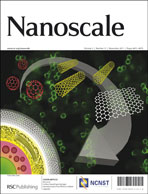Novel Zn–Sn–O nanocactus with excellent transport properties as photoanode material for high performance dye-sensitized solar cells†
Abstract
A novel chemically stable Zn–Sn–O nanocactus structure has been synthesized for the first time using a hydrothermal method. The Zn–Sn–O nanocactus structure comprises a Zn poor-Zn2SnO4 plate and Zn-doped SnO2 nanothorns growing on the plate, both of which have high electron mobilities. The nanocactus is used as the photoanode of


 Please wait while we load your content...
Please wait while we load your content...